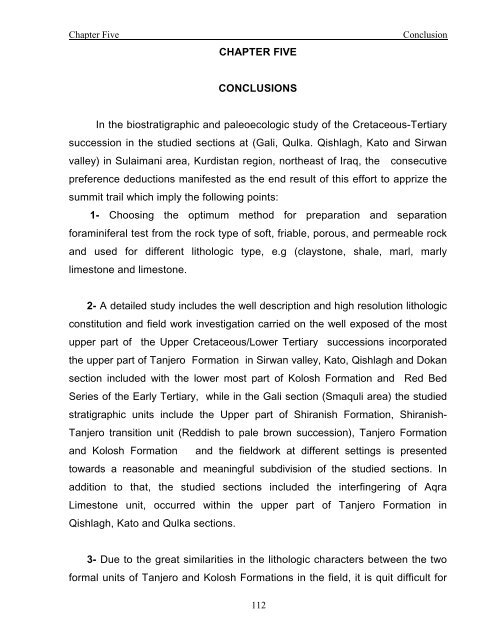biostratigraphy and paleoecology of cretaceous/tertiary boundary in ...
biostratigraphy and paleoecology of cretaceous/tertiary boundary in ...
biostratigraphy and paleoecology of cretaceous/tertiary boundary in ...
You also want an ePaper? Increase the reach of your titles
YUMPU automatically turns print PDFs into web optimized ePapers that Google loves.
Chapter Five<br />
CHAPTER FIVE<br />
Conclusion<br />
CONCLUSIONS<br />
In the biostratigraphic <strong>and</strong> paleoecologic study <strong>of</strong> the Cretaceous-Tertiary<br />
succession <strong>in</strong> the studied sections at (Gali, Qulka. Qishlagh, Kato <strong>and</strong> Sirwan<br />
valley) <strong>in</strong> Sulaimani area, Kurdistan region, northeast <strong>of</strong> Iraq, the consecutive<br />
preference deductions manifested as the end result <strong>of</strong> this effort to apprize the<br />
summit trail which imply the follow<strong>in</strong>g po<strong>in</strong>ts:<br />
1- Choos<strong>in</strong>g the optimum method for preparation <strong>and</strong> separation<br />
foram<strong>in</strong>iferal test from the rock type <strong>of</strong> s<strong>of</strong>t, friable, porous, <strong>and</strong> permeable rock<br />
<strong>and</strong> used for different lithologic type, e.g (claystone, shale, marl, marly<br />
limestone <strong>and</strong> limestone.<br />
2- A detailed study <strong>in</strong>cludes the well description <strong>and</strong> high resolution lithologic<br />
constitution <strong>and</strong> field work <strong>in</strong>vestigation carried on the well exposed <strong>of</strong> the most<br />
upper part <strong>of</strong> the Upper Cretaceous/Lower Tertiary successions <strong>in</strong>corporated<br />
the upper part <strong>of</strong> Tanjero Formation <strong>in</strong> Sirwan valley, Kato, Qishlagh <strong>and</strong> Dokan<br />
section <strong>in</strong>cluded with the lower most part <strong>of</strong> Kolosh Formation <strong>and</strong> Red Bed<br />
Series <strong>of</strong> the Early Tertiary, while <strong>in</strong> the Gali section (Smaquli area) the studied<br />
stratigraphic units <strong>in</strong>clude the Upper part <strong>of</strong> Shiranish Formation, Shiranish-<br />
Tanjero transition unit (Reddish to pale brown succession), Tanjero Formation<br />
<strong>and</strong> Kolosh Formation <strong>and</strong> the fieldwork at different sett<strong>in</strong>gs is presented<br />
towards a reasonable <strong>and</strong> mean<strong>in</strong>gful subdivision <strong>of</strong> the studied sections. In<br />
addition to that, the studied sections <strong>in</strong>cluded the <strong>in</strong>terf<strong>in</strong>ger<strong>in</strong>g <strong>of</strong> Aqra<br />
Limestone unit, occurred with<strong>in</strong> the upper part <strong>of</strong> Tanjero Formation <strong>in</strong><br />
Qishlagh, Kato <strong>and</strong> Qulka sections.<br />
3- Due to the great similarities <strong>in</strong> the lithologic characters between the two<br />
formal units <strong>of</strong> Tanjero <strong>and</strong> Kolosh Formations <strong>in</strong> the field, it is quit difficult for<br />
112

















